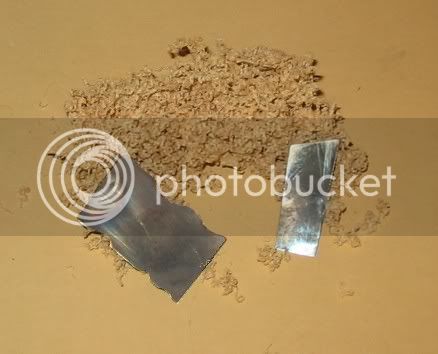When it comes to scrapers it doesn't take much to make your own.
These don't look like much but they work very well.
They were made out of some spring stock I bought from Dixie Gunworks.
After filing the shape I wanted I heat treated and tempered them to a blue color so they wouldn't be very hard.
They need to be somewhat soft in order to "roll the edge" on them.
A non-hardened piece of 1/32 or 1/16 piece of sheet metal will also work but it will have to be resharpened more often.
Unlike the glass scrapers some use, these have a true cutting edge on them.
The glass just scrapes wood off. These actually cut the wood off.
The edge is formed by placing the scraper into a vise or hanging it over a table edge for support.
Then, a really hard piece of steel like the shank of a drill bit up by the flutes is pressed against the edge of the scraper and rubbed back and forth.
The key to doing this is to remember that you are trying to roll the existing sharp edge at the end surface back up over the large flat part of the scraper.
If you could magnify it you would see the flat face of the scraper and as the surface approached the edge it would suddenly rise and start to curl back on itself forming a tiny hook.
In use, this tiny hook cuts into the wood and cuts it forming little curls of wood just like a plane does.
The sharpened edge will dull up as it is used but to resharpen it you just have to use the piece of hardened steel to roll a new cutting edge on the scraper.
A word about curly wood and scrapers.
Scrapers work great on straight grained wood as long as your scraping parallel with the woods grain.
Because the curl (stripes) of the wood has its grain going in a different direction depending on where your looking, scraping these woods can be difficult.
If it seems like the scraper is going to tear out a piece of the surface rather than cut it it's a good idea to change the direction your dragging the scraper.
It's also a good idea to know when the scraper is going to cause more trouble than its worth.







